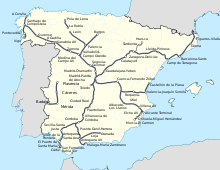
Transport in Spain is characterised by a network of roads, railways, trams, air routes, and ports. Its geographic location makes it an important link between Europe, Africa, and the Americas. Major forms of transit generally radiate from the capital, Madrid, located in the centre of the country, to link with the capitals of the autonomous communities.

Renfe, officially Renfe-Operadora, is Spain's national state-owned railway company.

Rail transport in Spain operates on four rail gauges and services are operated by a variety of private and public operators. The total route length in 2012 was 16,026 km.
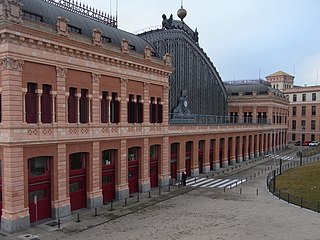
Madrid Atocha, also named Madrid Puerta de Atocha–Almudena Grandes, is the first major railway station in Madrid. It is the largest station serving commuter trains (Cercanías), regional trains from the south and southeast, intercity trains from Navarre, Cádiz and Huelva (Andalusia) and La Rioja, and the AVE high speed trains from Girona, Tarragona and Barcelona (Catalonia), Huesca and Zaragoza (Aragon), Sevilla, Córdoba, Málaga and Granada (Andalusia), Valencia, Castellón and Alicante. These train services are run by Spain's national rail company, Renfe. As of 2019, this station has daily services to Marseille, France.

Alta Velocidad Española (AVE) is a high-speed rail service operated by Renfe, the Spanish State railway company.
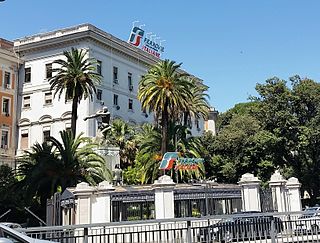
Trenitalia is the primary train operator in Italy. A subsidiary of Ferrovie dello Stato Italiane, itself partly owned by the Italian government, the company and partly from a private investors group. It was established in 2000 following a European Union directive on the deregulation of rail transport.
Air Nostrum, legally incorporated as Air Nostrum Líneas Aéreas del Mediterráneo, S.A., is a Spanish regional airline based in Valencia.
High-speed railways in Spain are in operation since 1992 when the first line was opened connecting the cities of Madrid, Córdoba and Seville. Unlike the rest of the Iberian broad gauge network, the Spanish High-speed network mainly uses standard gauge. This permits direct connections to outside Spain through the link to the French network at the Perthus Tunnel. High-speed trains run on a network of high-speed rail track owned and managed by ADIF, where the dominant service is AVE while other high speed services such as Avant, Alvia, Avlo, Euromed, Ouigo España and Iryo, as well as mid-speed (Altaria) services also operate.
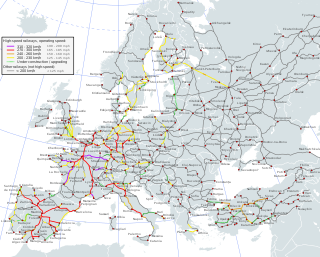
High-speed rail (HSR) has developed in Europe as an increasingly popular and efficient means of transport. The first high-speed rail lines on the continent, built in the 1970s, 1980s, and 1990s, improved travel times on intra-national corridors. Since then, several countries have built extensive high-speed networks, and there are now several cross-border high-speed rail links. Railway operators frequently run international services, and tracks are continuously being built and upgraded to international standards on the emerging European high-speed rail network.

In rail transport, an open-access operator is an operator that takes full commercial risk, running on infrastructure owned by a third party and buying paths on a chosen route and, in countries where rail services run under franchises, are not subject to franchising.

The Renfe Class 100 is a high-speed train used for AVE services by the Renfe Operadora, in Spain. It was the first high-speed train put into service in Spain, in 1992.
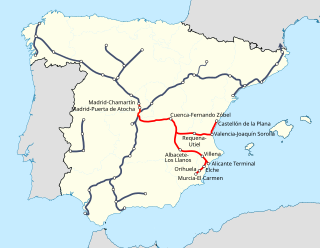
The Madrid–Levante high-speed network is a network of high-speed rail lines that connects Madrid with the Mediterranean coast of the Levante Region, specifically with Castilla-La Mancha, the Valencian Community and the Murcia Region autonomous communities.

The Frecciarossa 1000, is a high-speed train operated by Italian state railway operator Trenitalia and the private Spanish high-speed rail operator Iryo. It was co-developed as a joint venture between Italian rail manufacturer Hitachi Rail Italy and multinational conglomerate Alstom. Both design and production work were divided between the two partner companies.
Cuenca – Fernando Zóbel Railway Station is the new railway station in Cuenca, Spain, located 5 kilometres (3.1 mi) from the city centre. The station is named after painter Fernando Zóbel to commemorate his links to the city. It occupies 3.950 square metres (42.52 sq ft) with 8.900 square metres (95.80 sq ft) of parking space. It is operated by RENFE and part of Adif and high-speed rail systems.
The West Coast Partnership (WCP) is a railway franchise in the United Kingdom for passenger trains on the West Coast Main Line (WCML), between London Euston, the West Midlands, Shropshire, North Wales, Liverpool, Manchester, Carlisle, Edinburgh and Glasgow. Founded in December 2019, it is currently operated by First Trenitalia West Coast Rail Limited, comprising two distinct parts, Avanti West Coast which runs the current services on the WCML, and West Coast Partnership Development, which is the 'shadow operator' for future high-speed services.

Avlo is a low-cost high-speed rail service operated by Spanish national rail company Renfe, offering services connecting major Spanish cities such as Madrid, Zaragoza, Barcelona, Valencia, Alicante and others on specific high-speed lines.

Avanti West Coast is a British train operating company owned by FirstGroup (70%) and Trenitalia (30%) that operates the West Coast Partnership.
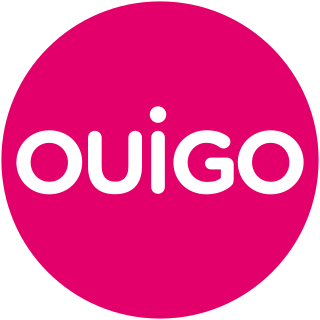
Ouigo España is an open-access operator of high-speed railway services in Spain. It is a subsidiary of SNCF Voyageurs, the French national railway company, and uses its trademark Ouigo.
Globalvia is a Spanish multinational transport infrastructure company that operates in 11 countries across three continents. In June 2022, Globalvia in partnership with Kinetic Group launched a takeover bid for the British bus and rail operator Go-Ahead Group. The sale was approved by Go-Ahead's shareholders in August 2022. Globalvia has a 49% shareholding.
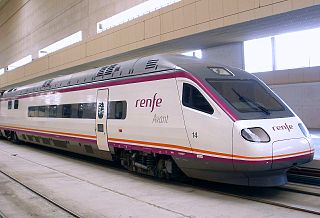
Avant is a high-speed, medium-distance passenger transport rail service, operated in Spain by the Spanish public company Renfe. Avant services circulate at a maximum speed of 250 km/h, compared to the 300 km/h maximum speed of the AVE service. Their routes usually cover different provinces within the same autonomous community or between neighboring ones. Regional services at conventional speed are called Renfe Media Distancia.


















